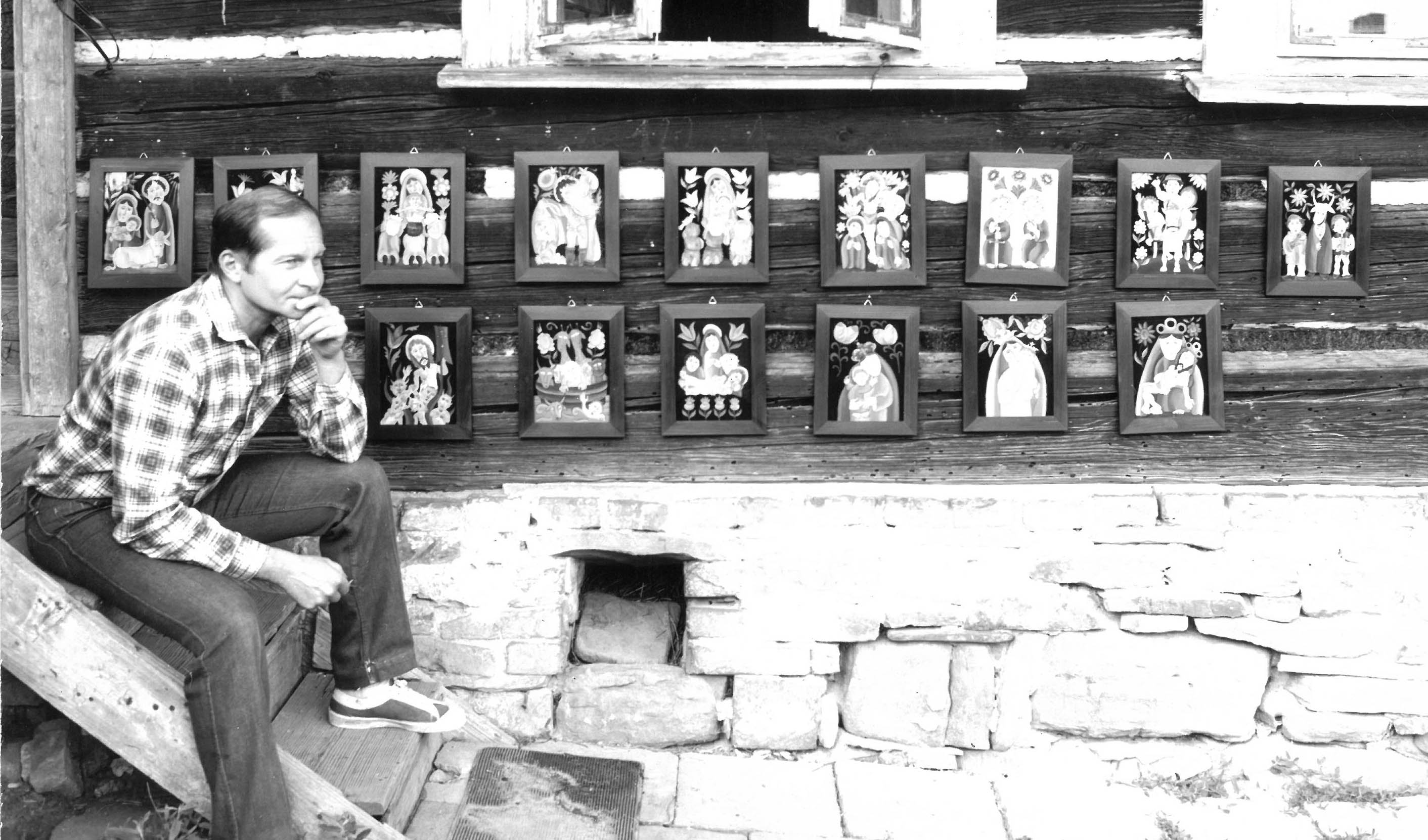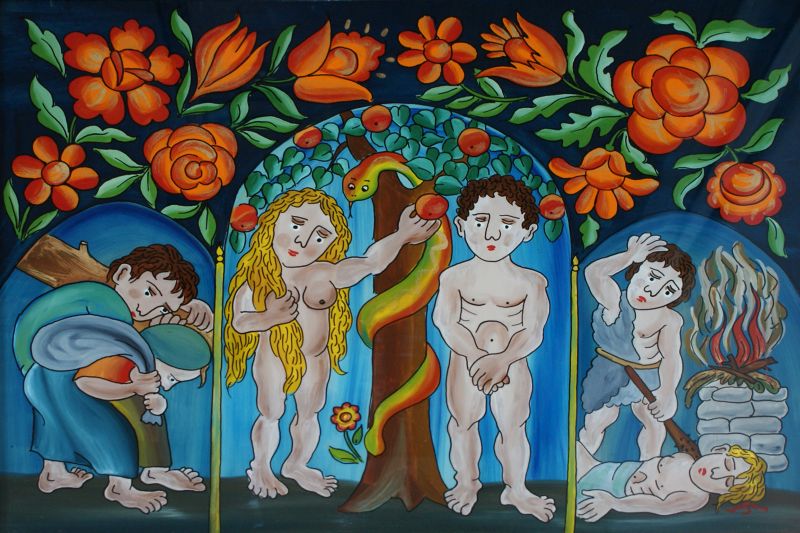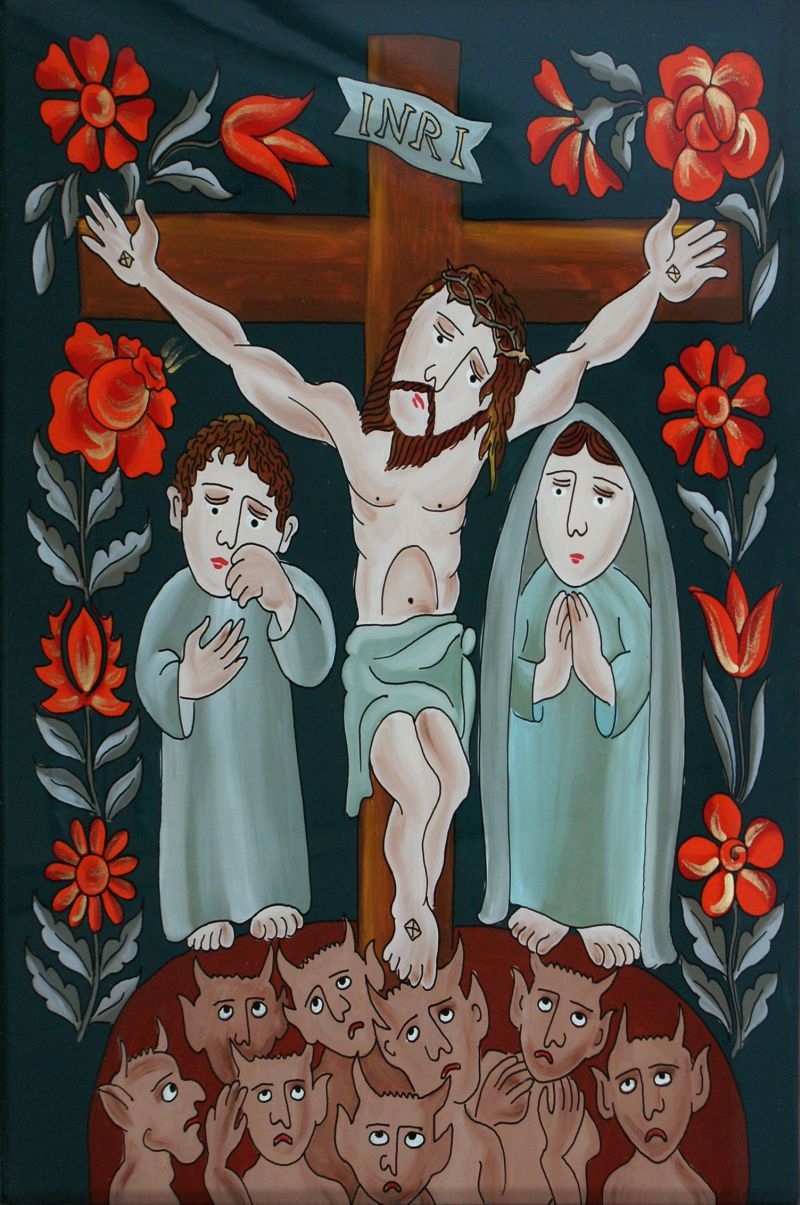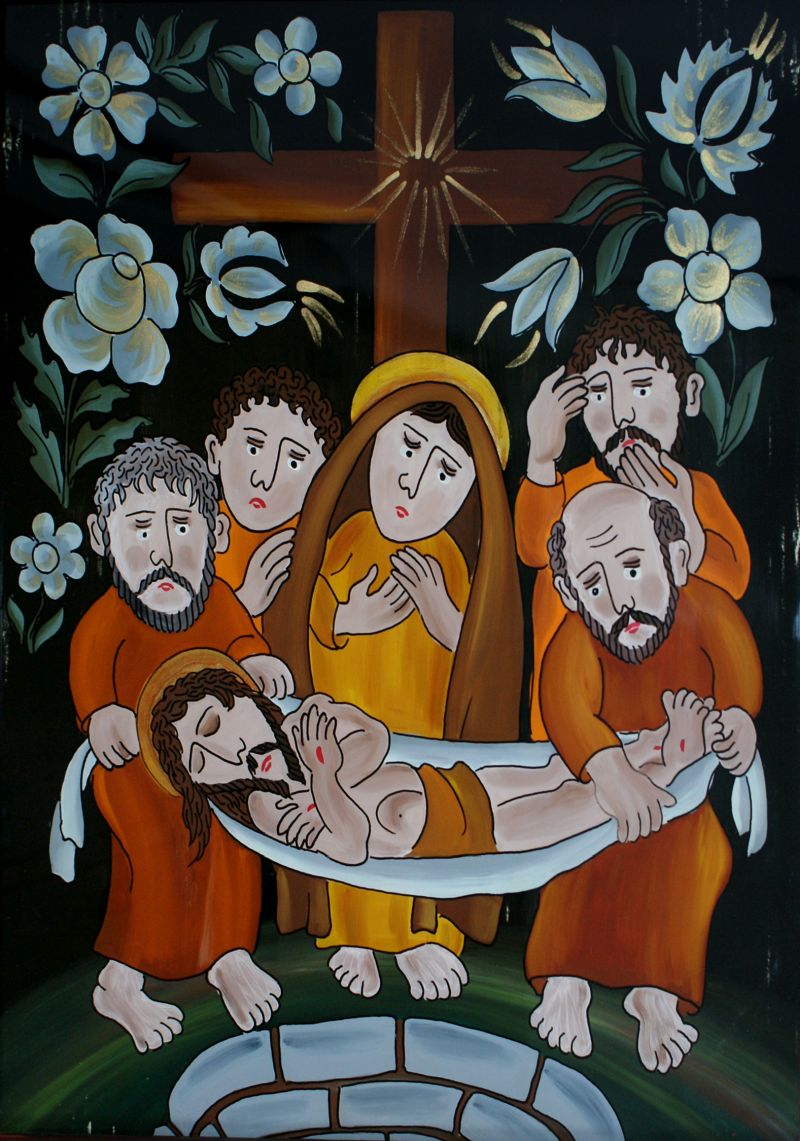Exhibition
Exhibition "Piotr Piotrowski - painting on glass"
Piotr Piotrowski was born in 1948 in Nowy Sącz, he graduated from the 1st Secondary School. J. Długosz, and then in 1968-73 he studied ethnography at the Jagiellonian University in Kraków. The choice of his field of study was partly related to his passion for mountains and hiking in the Beskids, which he had been devoted to with great pleasure since his school years. In the years of his youth, the village of Nowy Sącz was not much different from today's open-air museums. While wandering around the Beskids, you could see interesting old architecture at every step; cottages, barns, forges, granaries, cellars, etc. objects, but also very picturesque ancient chapels with old folk sculptures and paintings. Such Beskid "atmospheres" stimulated the young man's ethnographic and artistic imagination.
The combination of these two interests led me to choose the field of humanities studies. An additional "stimulus" to undertake them was the desire to "escape" the army, i.e. the then obligatory two-year compulsory military service. Needless to say, such a long break after the high school final exams reduced to a minimum the chances of passing the then very difficult entrance exams to universities.
During his studies, Piotr Piotrowski had a unique opportunity to be a student of the entire ethnographic professorial elite of Krakow at that time. With justifiable pride, he shows the index, which contains the signatures of such "monumental figures" of Polish ethnography as, among others, professors Roman Reinfuss, Mieczysław Gładysz, Andrzej Waligórski, Jadwiga Klimaszewska, as well as dr.dr. Teresa Dobrowolska and Anna Zambrzycka, or the then young M.A. Czesław Robotycki, the future fame of Krakow science. As an ethnography student, he also completed a summer internship under the supervision of Maria Brylak-Załuska in the open-air museum in Nowy Sącz.
Dr. Jan Bujak, a specialist in ethnographic museology, encouraged him to take up professional work at the Museum after graduating. Władysław Orkan in Rabka, which was managed by his wife, "Maryna" Bujakowa, a legendary figure of culture and regionalism in the Rabka area.
During his studies, Piotr Piotrowski had a unique opportunity to be a student of the entire ethnographic professorial elite of Krakow at that time. With justifiable pride, he shows the index, which contains the signatures of such "monumental figures" of Polish ethnography as, among others, professors Roman Reinfuss, Mieczysław Gładysz, Andrzej Waligórski, Jadwiga Klimaszewska, as well as dr.dr. Teresa Dobrowolska and Anna Zambrzycka, or the then young M.A. Czesław Robotycki, the future fame of Krakow science. As an ethnography student, he also completed a summer internship under the supervision of Maria Brylak-Załuska in the open-air museum in Nowy Sącz.
Dr. Jan Bujak, a specialist in ethnographic museology, encouraged him to take up professional work at the Museum after graduating. Władysław Orkan in Rabka, which was managed by his wife, "Maryna" Bujakowa, a legendary figure of culture and regionalism in the Rabka area.
Rabka was a very convenient place for him, as it was close to Krakow, his hometown Nowy Sącz and Zakopane, where his next passion - cave wandering and mountaineering - increasingly called him. He personally knew many outstanding Polish mountaineers and mountaineers. Earlier, as a junior, he practiced alpine skiing and took part in, among others, in a competition in Prehyb, where he met the legendary Home Army courier from World War II and ski coach Roman Stramka, whom he remembered as a man of iron condition and incredible fitness. In the meantime, the army "got him" anyway, from which he tried to "shelter" at the university, but one year of military service after graduation is not two years of conscript service.
It was while working at the Rabka Museum, in the years 1973-79, that he became interested in painting on glass. He really liked the paintings of Janina Sierosławska, a painter from Rabka, and Ewelina Pęksowa from Zakopane, and he decided to try this field of art. And he was a "restless artistic spirit", he already had "carpentry skills", because his artistic work in wood and his interest in the decorative aspect of wooden architecture began while he was still a student. This interest in wood bore fruit in the 1980s, when he started carving shrines. However, painting took priority.
It was while working at the Rabka Museum, in the years 1973-79, that he became interested in painting on glass. He really liked the paintings of Janina Sierosławska, a painter from Rabka, and Ewelina Pęksowa from Zakopane, and he decided to try this field of art. And he was a "restless artistic spirit", he already had "carpentry skills", because his artistic work in wood and his interest in the decorative aspect of wooden architecture began while he was still a student. This interest in wood bore fruit in the 1980s, when he started carving shrines. However, painting took priority.
He learned the painting technique himself and has been painting with oil paints from the very beginning. He painted mainly traditional religious subjects; various representations of the Virgin Mary and Lord Jesus, Crucifixion Scenes, figures of various patron saints, including those revered only regionally, such as St. Wendelin in Orava.
He also liked to present, often in a witty way, various genre scenes from life, work and celebrations in the highlander countryside. He certainly inherited his artistic talent to some extent from his father, Tadeusz Piotrowski, who, as an amateur, enjoyed painting with watercolors. There are still many paintings in the apartment made by my father and other artists who were friends of the family.
He also liked to present, often in a witty way, various genre scenes from life, work and celebrations in the highlander countryside. He certainly inherited his artistic talent to some extent from his father, Tadeusz Piotrowski, who, as an amateur, enjoyed painting with watercolors. There are still many paintings in the apartment made by my father and other artists who were friends of the family.
The high artistic level of Piotrowski's painting was quickly noticed and appreciated in the museum and ethnographic environment. The artist, although it would be difficult to classify him as an authentic folk artist, created in a folk style and was inspired by folk culture and art, willingly took part in various competitions and exhibitions, often winning awards in the category of "non-folk and folk artists going beyond traditional art" . The greatest success was the 1st Prize in the Contemporary Painting on Glass Competition of the Polish Carpathians, organized in 1976 by the Museum in Rabka, in which the chairman of the jury was prof. R. Reinfuss.
He does not hide the fact that his work gave not only artistic satisfaction, but was also a source of additional income. He cooperated with DESA and Cepelia, which had a state monopoly on foreign trade in works of art in the 1970s and 1980s. Thanks to this, his works reached collectors in various countries. In Poland, they were included in the collections of several ethnographic and regional museums, the largest collection is held by the Museum in Rabka, which documented his achievements on an ongoing basis. The paintings presented at the exhibition were made between 1975 and 2000.
The professional level of Piotr Piotrowski's work was confirmed by the Ministry of Culture and Art, issuing a document in 1988 granting him the right to practice as a visual artist.
In 1979, he started working at the famous Rabcio Puppet Theater in Rabka. Working in the theater allowed him to use his artistic talents and passions to the fullest when designing and creating scenography for performances, of which he produced about a hundred. Thanks to the international reputation of the Rabka theater, which was invited to perform at various festivals, it also made it possible to get to know the world, which was the dream of every young ethnographer, but very difficult to achieve in those years. With the "Rabcio" theater, Piotrowski visited, among others, Sweden, Denmark, Spain, the USSR and the countries of former Yugoslavia. He worked in the theater until 2023, when he retired.
The professional level of Piotr Piotrowski's work was confirmed by the Ministry of Culture and Art, issuing a document in 1988 granting him the right to practice as a visual artist.
In 1979, he started working at the famous Rabcio Puppet Theater in Rabka. Working in the theater allowed him to use his artistic talents and passions to the fullest when designing and creating scenography for performances, of which he produced about a hundred. Thanks to the international reputation of the Rabka theater, which was invited to perform at various festivals, it also made it possible to get to know the world, which was the dream of every young ethnographer, but very difficult to achieve in those years. With the "Rabcio" theater, Piotrowski visited, among others, Sweden, Denmark, Spain, the USSR and the countries of former Yugoslavia. He worked in the theater until 2023, when he retired.





